The Aude
 Named after the Aude river, the Aude district is one of the most popular areas of the Languedoc. It's main city, Carcassonne, is one of the best preserved medieval towns in Europe. The Aude has a very interesting history. Giant dinosaurs walked on this turf many millions of years ago.. But the most famous story is that of the Cathars, who were brutally murdered in the 13th and 14th century. The area is littered with the so called Cathar Castles and is nicknamed Pays Cathare, Land of the Cathars. For a description of the most important of these castles, surf to our page: "The Cathars".
Named after the Aude river, the Aude district is one of the most popular areas of the Languedoc. It's main city, Carcassonne, is one of the best preserved medieval towns in Europe. The Aude has a very interesting history. Giant dinosaurs walked on this turf many millions of years ago.. But the most famous story is that of the Cathars, who were brutally murdered in the 13th and 14th century. The area is littered with the so called Cathar Castles and is nicknamed Pays Cathare, Land of the Cathars. For a description of the most important of these castles, surf to our page: "The Cathars".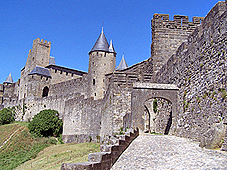 Carcassonne
CarcassonneThis city, which has two separate parts, is an absolute 'must' when you visit the Languedoc.
History
Before the Romans arrived, this particular site was already long inhabited. The Romans built their castellum in the 2nd century B.C. after which the first wall was erected around the fort. After the Romans, the Cité was a Visigoth stronghold. For a very short period it was even taken by the Moors. In this period, the best known legend of Carcassonne came into existence. The story of Madame Carcas, the wife of the Saraceen Balaak.
"When Charlemagne stood before the gates of Carcassonne with his troops, the castle army existed of only one person, Madame Carcas. She gave the illusion that many men were still on the walls. When Charlemagne wanted to starve the castle, and Dame Carcas heard of his plans, she threw a pig over the wall, filled with sweet corn. This made Charlemagne believe that there was still enough food left, so he packed up and left. On the site of his retrieve, she triumphantly blew her horn (Carcas sonne)."
Another story tells of the presence of sun temples or sun churches, which would have been responsible for the name Carcassonne (Karke Sonne). However, it is more likely that its name is based on the name of the Roman fortress, Carcasso. The connection with the sun temples and a possible Egyptian influence in its Celtic history is now a discussion between scholars.
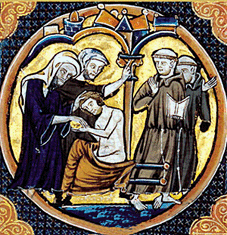 When Carcassonne was re-conquered from the Moors, it became the possession of several noble families, of which the Trencavel family was the last. In 1074, Lord Bernard Aton Trencavel was the Lord of Carcassonne and the Razés, Agde, Béziers, Albi and Nimes. In the 13th century, the city of Carcassonne had to surrender to the catholic army during the crusade against the Cathars. The 24-year old Count Raymond-Roger de Trencavel was taken prisoner and very badly treated, so that he died only a short time after. This news shocked the Languedoc. Trencavel offered a sanctuary to the Cathars and was therefore taking sides against the church of Rome.
In 1226, crusade leader Simon de Montfort gave Carcassonne to the French crown, after which a second wall was erected. The son of Raymond-Roger, also called Roger, tried to regain Carcassonne in 1240, but failed and fled to Barcelona. Louis IX, consequently, gave the order to destroy the houses around the castle, after which the inhabitants were driven out of the Cité. They weren't allowed to come back for at least 7 years. In 1248 they received permission to build the Ville Basse (Lower town) on the other side of the river Aude. In the middle of the 14th century, Froissart described Carcassonne as a flourishing town with about 7000 houses and famous for her textile industry. Unfortunately, this industry collapsed around the beginning of the 15th century. It wasn't until the 17th century that the city enjoyed another period of prosperity. In the years of the Revolution, Carcassonne didn't play a large part. However, the economic decay during the Revolution, as well as the Napoleonic Wars and the British Influence around the Mediterranean, ended this period of prosperity. In the late 19th century, Carcassonne renovated its historic buildings and tried to make profit from the wine industry. Today, much of its income and prosperity relies on the tourist industry.
When Carcassonne was re-conquered from the Moors, it became the possession of several noble families, of which the Trencavel family was the last. In 1074, Lord Bernard Aton Trencavel was the Lord of Carcassonne and the Razés, Agde, Béziers, Albi and Nimes. In the 13th century, the city of Carcassonne had to surrender to the catholic army during the crusade against the Cathars. The 24-year old Count Raymond-Roger de Trencavel was taken prisoner and very badly treated, so that he died only a short time after. This news shocked the Languedoc. Trencavel offered a sanctuary to the Cathars and was therefore taking sides against the church of Rome.
In 1226, crusade leader Simon de Montfort gave Carcassonne to the French crown, after which a second wall was erected. The son of Raymond-Roger, also called Roger, tried to regain Carcassonne in 1240, but failed and fled to Barcelona. Louis IX, consequently, gave the order to destroy the houses around the castle, after which the inhabitants were driven out of the Cité. They weren't allowed to come back for at least 7 years. In 1248 they received permission to build the Ville Basse (Lower town) on the other side of the river Aude. In the middle of the 14th century, Froissart described Carcassonne as a flourishing town with about 7000 houses and famous for her textile industry. Unfortunately, this industry collapsed around the beginning of the 15th century. It wasn't until the 17th century that the city enjoyed another period of prosperity. In the years of the Revolution, Carcassonne didn't play a large part. However, the economic decay during the Revolution, as well as the Napoleonic Wars and the British Influence around the Mediterranean, ended this period of prosperity. In the late 19th century, Carcassonne renovated its historic buildings and tried to make profit from the wine industry. Today, much of its income and prosperity relies on the tourist industry.
The Ville Basse
The lower town is a more modern place with several medieval remains. Interesting are the remains of the wall and gate near the main shopping street, the two churches of St.Vicent and St. Michel, and Place Carnot with the 18th century fountain of Neptune in the middle of the square. This square is the centre of the town, with its many terraces and shops.
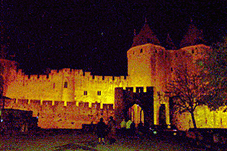 The Cité
The CitéThe oldest part is the Cité, the best kept medieval city in Europe. Here you can stroll around its medieval streets. The major attraction is the castle, which you can visit with a guide only. While waiting for the guide, you can take a look at the museum. The guide takes you from the main building over the walls to the other side. You cannot go back to the museum or the attached souvenir shop, so if you want to buy something or visit the museum, you can only do so before the guided tour. At the end of the tour you will see the old St. Nazaire church. This is a Roman/Gothic church with many legends of Templar treasure. Inside you will see among other things an image of the Holy Trinity, a statue of Anna and her daughter Mary, and in the chapel of the Notre Dame (13th century) you can see the Tree of Jesse. The most famous item is no doubt the Siege Stone, on which you can see the Siege of Carcassonne in 1209 by the crusaders.
It is interesting to take a walk in between the walls of the Cité, or do so by tourist train. In July and August there is a feast in the Cité almost every Saturday. Ask the tourist office for more information. The Cité is beautifully lit at night.
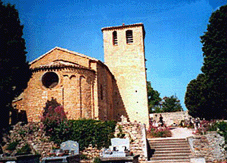 Rennes-le-Chateau
Rennes-le-ChateauThis place is more than just a village on another hill. It was originally part of an old fortified city called Rhedae, which, alongside Carcassonne, was an important city in ancient times. It also played a role in the legends of the Holy Grail and the Arc of the Covenant, as well as in the stories around the lost kings of the Visigoths and Merovingians. Templar gold was hidden in several of the many caves of the area. In the village church and the Magdala tower, new discoveries have been made. People from all over the world study the enigma of Rennes-le-Chateau. The area is dotted with ancient remains of Celtic and Roman times. The interesting church of La Madeleine at Rennes-le-Chateau reveals symbolism from forgotten times, double meanings, secret abbreviations... buying a booklet in the village bookshop is definitely worth the money. Discover the enigma of Rennes-le-Chateau and visit the museum about the mysterious life of Abbot Saunière. And finally, the view from the top of the Magdala Tower across the valley, where many historians, scientists and archaeologists are still pondering about today, is unforgettable. Especially when you can see the snow topped Pyrenees on a clear day.
You can have a nice refreshment in Le Jardin de Marie, near the ancient mysterious castle of Rennes, which is sometimes referred to as the temporary resting place of the Arc of the Covenant...
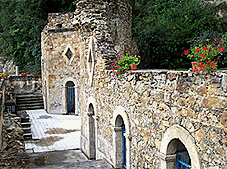 Rennes-les-Bains, situated on the other hill nearby, still has remains of an old Roman bath house. There is also a new bath house, where you can enjoy wellness arrangements. The little town is picturesque and on the square de 2 Rennes you find a bar and a pizzeria.
Rennes-les-Bains, situated on the other hill nearby, still has remains of an old Roman bath house. There is also a new bath house, where you can enjoy wellness arrangements. The little town is picturesque and on the square de 2 Rennes you find a bar and a pizzeria. In Rennes-les-Bains lived and worked the most important person in the enigma of Rennes-le-Chateau, Abbé Henri Boudet. His church is just off the main square. His book, "La Vraie Langue Celtique et le Cromleck le Rennes-les-Bains" has fooled many in the past hundred years. Some believe that there is a complete Kabbala tree of life, carefully placed in the valley surrounding Rennes-les-Bains, including the basic principles of the Hermetica. This ancient knowledge was under threat during the first 1500 years of Christianity and at the time it was believed that by hiding its principles and knowledge in the landscape, like a tattoo on the skin of the Mother Goddess herself, was the only way this ancient knowledge could survive the ages.
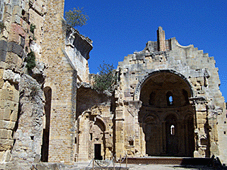 Alet-les-Bains
Alet-les-Bains There are two good reasons to visit this town. The first one is because of its beautiful lugubrious remains of the 11th century abbey church. In 1318, the Benedictine abbey of Alet was made a bishopric and the church became a cathedral. In 1577 the buildings were badly damaged during the wars against the Huguenots. The second reason to visit Alet are the authentic medieval market square with its beautiful half timbered houses and the 12th century city walls. Nostradamus lived in Alet for a while, his house still stands on the corner of the market square. At the hotel you can stop for a drink or a lovely ice-cream.
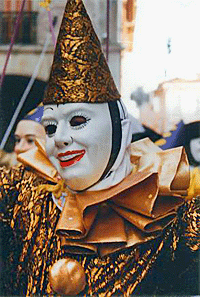 Limoux is famous for its bubbly wine, "Blanquette", which is often seen as the forerunner of the Champagne. Also the Carnival, which is celebrated in the Spring, attracts many visitors. Just like in Venice, the main items of the Carnival are the masks.
Limoux is famous for its bubbly wine, "Blanquette", which is often seen as the forerunner of the Champagne. Also the Carnival, which is celebrated in the Spring, attracts many visitors. Just like in Venice, the main items of the Carnival are the masks.Limoux is a nice place to shop and have lunch on one of the lovely terraces on the large market square. It also has a lovely museum called La Musée des Automates, where animated puppets steal the show.
A little outside the town there is a lovely garden to visit, just behind the garden centre behind Mr. Bricolage (near LeClerc) you follow the road to the Jardin la Bouichère/Domaine de Flassian. It is well worth a visit!
In Esperaza you will find an interesting Dinosaur Museum, where you can learn much about these prehistoric animals and evolution itself. It is also very nice for children. In the church of St. Michel you find a grotto with the body of Jesus. If you bring a torch, you can see that his eyes are slightly open. The statue and grotto were placed there by Abbé Rivière, the priest who denied Saunière of Rennes-le-Chateau his last rites.
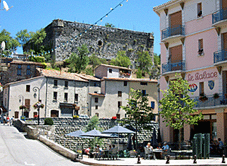 Quillan
QuillanThe old Gallo-Roman oppidum Kilianus was a strategic point in the High Valley of the Aude river. On this spot you could watch over the mountain pass and the through road from the Pyrenees towards Carcassonne. From this ancient period Quillan has always been inhabited. Also the Visigoths recognized the value of the old Roman fort and rebuilt it to fit their own needs in the early 8th century. The old remains of the Visigoth fortress are watching over today's Quillan, which is a terrific starting point for daytrips into the Pyrenees or the beautiful mountainous surroundings.
The Tourist Office is situated in the old Bathhouse on the main road. There you can collect leaflets and information on daytrips in the area. On Wednesdays and Fridays there is a market. Especially on Wednesdays the market stretches from the little train station to the far end of the town centre. Do try some Churros, a typical delicacy of the southern Languedoc. And when you love pizza's then Quillan is the place to be. However, the Auberge du Chalet on the road to Perpignan, about 3 km south of Quillan, serves local dishes and while you are there, drive a little bit further towards Axat to see the spectacular gorge of Pierre Lys.
You can follow the river Aude up to the source near Font Romeu, an amazing mountain journey with ruined castles and caves, ancient villages, wintersport centres such as Les Angles and wonderful views. A visit to Mont Louis, now on the UNESCO list of World Heritage, is a 'must'.